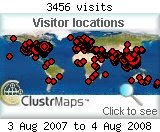10/16/2007 11:59 AM / GMANews.tv
The Philippines's rapid population growth rate is one of the primary reasons hindering the country from attaining the millenium development goals, as it dilutes the impact of economic growth and policy improvements, a joint report by the government and the United Nations showed.
In a statement, the Philippine Legislators Committee on Population and Development Foundation Inc., said that the Philippines, with a growth rate that is one of the highest in Asia, still has a long way to go before it makes noteworthy progress on the eight MDGs.
"Among the challenges and priorities for action that must be viewed with urgency is the rapid population growth," the PLCPD said, quoting the Philippines Midterm Progress Report on MDGs jointly released by the UN and the National Economic and Development Authority.
"Rapid population growth rate is closely linked to persistent poverty as it reduces overall economic growth and prospects for poverty reduction. It strains the environment as competition for scarce resources and public goods expands," the report continues.
If the rapid growth of the Philippines's population is not addressed, PLCPD said the country's population would hit 102.55 million by 2015, a number sure to tax the Philippine economy and environment. However, PLCPD said that as of now, the government is doing very little to address this problem.
“The Philippines, along with 191 member states of the United Nations, signed the Millennium Declaration in September 2000. Eight years after, the country still lacks a comprehensive national law that would address our population management problem," said Ramon San Pascual, executive director of the PLCPD.
San Pascual said that the current administration has instead let local government units shoulder the burden of implementing policy on population and reproductive health. "However, without sufficient budget allocation from the (national) government, any LGU efforts will not be sustained," San Pascual said.
There are eight MDGs that should be achieved by 2015: halving extreme poverty, achieving universal primary education, promoting gender equality and empowerment, reducing child mortality, improving maternal health, halting the spread of HIV/AIDS and other diseases, ensuring environmental sustainability, and developing a global partnership for development.
However, a report by the Asian Development Bank, has showed that no developing country in the Asia-Pacific region, including the Philippines, will be able to meet all millennium development goals by 2015.
“The region still faces quite a challenge. Most of the developing countries can point to success in some of the goals, but none is on course to achieve all of them," the regional lender's The Millennium Development Goals: Progress in Asia and the Pacific 2007 report said.
Philippine hits and misses
The ADB said that among the 21 criteria under seven MDGs, the Philippines is either slow or showing no progress in nine categories. There are eight MDGs: halving extreme poverty, achieving universal primary education, promoting gender equality and empowerment, reducing child mortality, improving maternal health, halting the spread of HIV/AIDS and other diseases, ensuring environmental sustainability, and developing a global partnership for development, by the target date of 2015-- but the ADB study did not release a rating for the global partnership goal.
The multilateral lender noted that the Philippines is slow in reducing the number of its population living in $1 a day, reducing the number of underweight children, providing sufficient water, and improved sanitation both in rural areas.
The Philippines, the ADB report said, is either showing no progress or even regressing in the MDG criteria of number of primary education enrollees, number of those able to reach 5th grade, forest cover, carbon dioxide emission and water accessibility in urban areas.
However, the ADB also said the Philippines is an early achiever in the following MDG criteria: primary completion rate, gender primary, gender secondary, gender tertiary, tuberculosis prevalence rate, turbeculosis death rate, increasing the number of its protected areas, and ozone-depleting CFCs consumption.
Besides this, the ADB lauded the Philippines for making progress in reducing under-five mortality, infant mortality, people with HIV, and improving urban sanitation.
The Philippines's rapid population growth rate is one of the primary reasons hindering the country from attaining the millenium development goals, as it dilutes the impact of economic growth and policy improvements, a joint report by the government and the United Nations showed.
In a statement, the Philippine Legislators Committee on Population and Development Foundation Inc., said that the Philippines, with a growth rate that is one of the highest in Asia, still has a long way to go before it makes noteworthy progress on the eight MDGs.
"Among the challenges and priorities for action that must be viewed with urgency is the rapid population growth," the PLCPD said, quoting the Philippines Midterm Progress Report on MDGs jointly released by the UN and the National Economic and Development Authority.
"Rapid population growth rate is closely linked to persistent poverty as it reduces overall economic growth and prospects for poverty reduction. It strains the environment as competition for scarce resources and public goods expands," the report continues.
If the rapid growth of the Philippines's population is not addressed, PLCPD said the country's population would hit 102.55 million by 2015, a number sure to tax the Philippine economy and environment. However, PLCPD said that as of now, the government is doing very little to address this problem.
“The Philippines, along with 191 member states of the United Nations, signed the Millennium Declaration in September 2000. Eight years after, the country still lacks a comprehensive national law that would address our population management problem," said Ramon San Pascual, executive director of the PLCPD.
San Pascual said that the current administration has instead let local government units shoulder the burden of implementing policy on population and reproductive health. "However, without sufficient budget allocation from the (national) government, any LGU efforts will not be sustained," San Pascual said.
There are eight MDGs that should be achieved by 2015: halving extreme poverty, achieving universal primary education, promoting gender equality and empowerment, reducing child mortality, improving maternal health, halting the spread of HIV/AIDS and other diseases, ensuring environmental sustainability, and developing a global partnership for development.
However, a report by the Asian Development Bank, has showed that no developing country in the Asia-Pacific region, including the Philippines, will be able to meet all millennium development goals by 2015.
“The region still faces quite a challenge. Most of the developing countries can point to success in some of the goals, but none is on course to achieve all of them," the regional lender's The Millennium Development Goals: Progress in Asia and the Pacific 2007 report said.
Philippine hits and misses
The ADB said that among the 21 criteria under seven MDGs, the Philippines is either slow or showing no progress in nine categories. There are eight MDGs: halving extreme poverty, achieving universal primary education, promoting gender equality and empowerment, reducing child mortality, improving maternal health, halting the spread of HIV/AIDS and other diseases, ensuring environmental sustainability, and developing a global partnership for development, by the target date of 2015-- but the ADB study did not release a rating for the global partnership goal.
The multilateral lender noted that the Philippines is slow in reducing the number of its population living in $1 a day, reducing the number of underweight children, providing sufficient water, and improved sanitation both in rural areas.
The Philippines, the ADB report said, is either showing no progress or even regressing in the MDG criteria of number of primary education enrollees, number of those able to reach 5th grade, forest cover, carbon dioxide emission and water accessibility in urban areas.
However, the ADB also said the Philippines is an early achiever in the following MDG criteria: primary completion rate, gender primary, gender secondary, gender tertiary, tuberculosis prevalence rate, turbeculosis death rate, increasing the number of its protected areas, and ozone-depleting CFCs consumption.
Besides this, the ADB lauded the Philippines for making progress in reducing under-five mortality, infant mortality, people with HIV, and improving urban sanitation.













0 comments:
Post a Comment